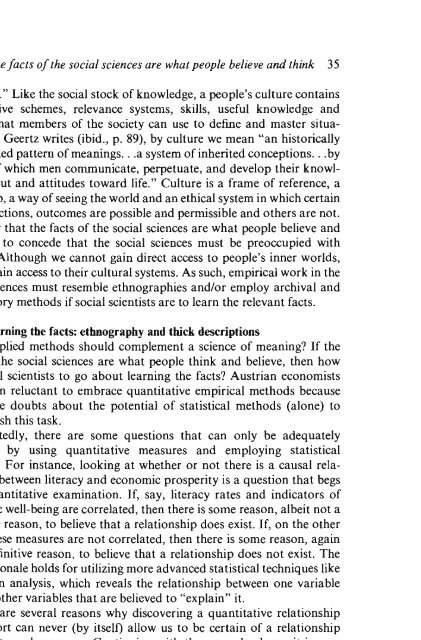Handbook on Contemporary Austrian Economics
Handbook on Contemporary Austrian Economics
Handbook on Contemporary Austrian Economics
You also want an ePaper? Increase the reach of your titles
YUMPU automatically turns print PDFs into web optimized ePapers that Google loves.
The facts of the social sciences are what people believe and think 35<br />
has spun." Like the social stock of knowledge, a people's culture c<strong>on</strong>tains<br />
interpretive schemes, relevance systems, skills, useful knowledge and<br />
recipes that members of the society can use to define and master situati<strong>on</strong>s.<br />
As Geertz writes (ibid., p. 89), by culture we mean "an historically<br />
transmitted pattern of meanings ... a system of inherited c<strong>on</strong>cepti<strong>on</strong>s ... by<br />
means of which men communicate, perpetuate, and develop their knowledge<br />
about and attitudes toward life." Culture is a frame of reference, a<br />
backdrop, a way of seeing the world and an ethical system in which certain<br />
beliefs, acti<strong>on</strong>s, outcomes are possible and permissible and others are not.<br />
To say that the facts of the social sciences are what people believe and<br />
think, is to c<strong>on</strong>cede that the social sciences must be preoccupied with<br />
culture. Although we cannot gain direct access to people's inner worlds,<br />
we can gain access to their cultural systems. As such, empirical work in the<br />
social sciences must resemble ethnographies and/or employ archival and<br />
oral history methods if social scientists are to learn the relevant facts.<br />
3.3 Learning the facts: ethnography and thick descripti<strong>on</strong>s<br />
What applied methods should complement a science of meaning If the<br />
facts of the social sciences are what people think and believe, then how<br />
are social scientists to go about learning the facts <strong>Austrian</strong> ec<strong>on</strong>omists<br />
have been reluctant to embrace quantitative empirical methods because<br />
they have doubts about the potential of statistical methods (al<strong>on</strong>e) to<br />
accomplish this task.<br />
Admittedly, there are some questi<strong>on</strong>s that can <strong>on</strong>ly be adequately<br />
explored by using quantitative measures and employing statistical<br />
methods. For instance, looking at whether or not there is a causal relati<strong>on</strong>ship<br />
between literacy and ec<strong>on</strong>omic prosperity is a questi<strong>on</strong> that begs<br />
for a quantitative examinati<strong>on</strong>. If, say, literacy rates and indicators of<br />
ec<strong>on</strong>omic well-being are correlated, then there is some reas<strong>on</strong>, albeit not a<br />
definitive reas<strong>on</strong>, to believe that a relati<strong>on</strong>ship does exist. If, <strong>on</strong> the other<br />
hand, these measures are not correlated, then there is some reas<strong>on</strong>, again<br />
not a definitive reas<strong>on</strong>, to believe that a relati<strong>on</strong>ship does not exist. The<br />
same rati<strong>on</strong>ale holds for utilizing more advanced statistical techniques like<br />
regressi<strong>on</strong> analysis, which reveals the relati<strong>on</strong>ship between <strong>on</strong>e variable<br />
and the other variables that are believed to "explain" it.<br />
There are several reas<strong>on</strong>s why discovering a quantitative relati<strong>on</strong>ship<br />
of this sort can never (by itself) allow us to be certain of a relati<strong>on</strong>ship<br />
between two phenomena. C<strong>on</strong>tinuing with the example above, it is possible<br />
that the measures that we used for literacy and ec<strong>on</strong>omic well-being<br />
are poor measures of the actual phenomena. If our measures are imperfect,<br />
then the meaning of any relati<strong>on</strong>ship between them is suspect. Moreover,<br />
even if our measures are perfect, the statistical relati<strong>on</strong>ship that we find

















